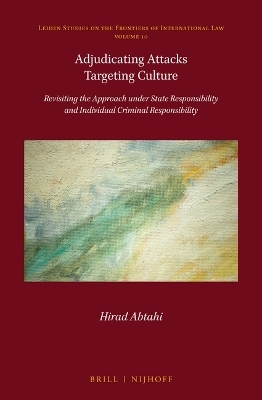
Adjudicating Attacks Targeting Culture
Martinus Nijhoff (Verlag)
978-90-04-53346-2 (ISBN)
Hirad Abtahi (PhD, Leiden University) is the Chef de Cabinet at the Presidency of the International Criminal Court, which he joined in 2004 as its first head of the legal team. Previously, he served the Milošević trial chamber at the International Criminal Tribunal for the former Yugoslavia. Hirad Abtahi is faculty member at Science Po’s Paris School of International Affairs. He has extensively lectured and published in English, French and Persian.
Laudatio PhD
Preface
Acknowledgements
List of Tables
Abbreviations
General Introduction Mapping Attacks Targeting Culture
1 Background and Primary Research Question
1.1 Treaty Law and Modes of Responsibility: Legal Niches or Anthropological Uncertainty?
1.2 Academia: Specialisation or Compartmentalisation?
2 Conceptualising Attacks Targeting Culture
2.1 Culture as a Metaphorical Triptych
2.2 Ways of Attacking Culture: Tangible-Centred or Heritage-Centred?
3 Proposed Framework and Tools
3.1 Placing Culture in Linguistics and Anthropology
3.2 Placing Culture in a Legal Mould
3.3 Placing Culture in Judicial Proceedings
4 Roadmap
Part 1
State Responsibility
Introduction Attacks Targeting Culture – A Westphalian Foresight?
1 Inter-State Claim Mechanisms
1 Introduction: The Subject-Matters of Injury and Terminological Challenges
2 Legal Persons: Actual and Prospective Tangible-Centred Approach
2.1 Direct Injury to States
2.2 Indirect Injury to States: Injury to States’ Nationals – Legal Persons
2.3 Synthesis: Westphalian Avant-Gardism Regarding Legal Persons and Cultural Property
3 Natural Persons: A Prospective Heritage-Centred Approach?
3.1 Direct Injury: Armed Activities and Peacetime
3.2 Indirect Injury: Material and Moral Injury to Third Parties
3.3 Synthesis: Westphalian Avant-Gardism Regarding Natural Persons
4 Conclusion to Chapter 1
2 Regional Human Rights Courts
1 Introduction: The Subject-Matters of Damage and Terminological Challenges
2 Natural Persons: The Heritage-Centred Approach
2.1 Natural Persons as Members of the Collective
2.2 The Collective as the Sum of Natural Persons
2.3 Synthesis: A Heritage-Centred Approach Grounded on Damages’ Typology and Victims
3 Legal Persons: The Tangible-Centred Approach
3.1 Victims: Legal Persons as Such
3.2 Damage: Legal Persons’ Natural Person Members
3.3 Synthesis: From Legal Persons to “Living Organisms”
4 Conclusion to Chapter 2
Conclusion to Part 1: State Responsibility’s Groundwork for Individual Criminal Responsibility
Part 2
Individual Criminal Responsibility
Introduction Attacks Targeting Culture – A Tripartite Crime Matter?
3 War Crimes
1 Introduction: Crimes Concerned with Tangible Culture Only?
2 The Tangible-Centred Approach: ihl and icl Instruments
2.1 Introduction
2.2 Direct Protection: Cultural Property as Such
2.3 Indirect Protection of Culture’s Tangible as Movable and Immovable of a Civilian Character
2.4 Synthesis: Direct Protection as Lex Specialis to Indirect Protection
3 Towards a Heritage-Centred Approach: Dubrovnik and Timbuktu
3.1 Introduction
3.2 ihl-icl Intersecting with Peacetime Instruments
3.3 The Collective and Its Anthropical Environment
3.4 Synthesis: Blurring the Distinction between the Peacetime and Non-peacetime Legal Regimes?
4 Conclusion to Chapter 3: Tangible-Centred Means with Heritage-Centred (Intent and) Consequences
4 Crimes against Humanity
1 Introduction: Crimes Coined by the Clash of Civilisations
2 The Anthropo-centred Approach
2.1 Introduction
2.2 The Chapeau Elements: Attacks against a Collective
2.3 The Underlying Offences: The Crime of Persecution
2.4 Synthesis: Crimes Immersed in Collective Rights Violations
3 The Tangible-Centred Approach: The Actus Reus of the Crime of Persecution
3.1 Introduction
3.2 The Post-Second World War Trials
3.3 The Post-Cold War International Criminal Jurisdictions
3.4 Synthesis: Heritage-Oriented Attacks Targeting Tangible Culture
4 Conclusion to Chapter 4: Fundamental (Cultural) Rights Violations – Between War Crimes and Genocide?
5 Genocide
1 Introduction: An Intrinsically Anthropological Crime
2 Drafting the Convention
2.1 Introduction
2.2 The Chapeau: Genocide Is Cultural
2.3 The Actus Rei: Heritage-Centred or Tangible-Centred?
2.4 Synthesis: Confusing Genocide’s Tangible- and Heritage-Centred Means
3 Practice of International Criminal Jurisdictions and the icj
3.1 Introduction: The Group’s Physical/Biological Destruction – A Questionable Mantra
3.2 Anthropo-Centred Violence through the Genocide Convention’s Actus Rei
3.3 Tangible-Centred Violence Indicative of Genocidal Intent
3.4 Synthesis: Ethnic Cleansing’s Heightened Mens Rea
4 Conclusion to Chapter 5: Cultural Genocide Is a Tautology
Conclusion to Part 2: Individual Criminal Responsibility’s Promising Potential
General Conclusion Emerging Trends and Future Promises
1 Introspection: Culture as a Heritage-Centred and Tangible-Centred Triptych
1.1 Culture as an Anthropical and Natural Concept
1.2 Culture as a Legacy-Oriented Concept
2 Retrospection: State Responsibility and Individual Criminal Responsibility’s Converging Paths
2.1 The Typology of Cultural Damage
2.2 The Victims of Cultural Damage
3 Prospection: State Responsibility and Individual Criminal Responsibility’s Osmotic Paths
3.1 Towards a Synergetic Experience
3.2 The Three Pillars for the Right Question
Bibliography
Index
| Erscheinungsdatum | 29.12.2022 |
|---|---|
| Reihe/Serie | Leiden Studies on the Frontiers of International Law ; 10 |
| Sprache | englisch |
| Maße | 155 x 235 mm |
| Gewicht | 785 g |
| Themenwelt | Recht / Steuern ► EU / Internationales Recht |
| ISBN-10 | 90-04-53346-X / 900453346X |
| ISBN-13 | 978-90-04-53346-2 / 9789004533462 |
| Zustand | Neuware |
| Haben Sie eine Frage zum Produkt? |
aus dem Bereich


